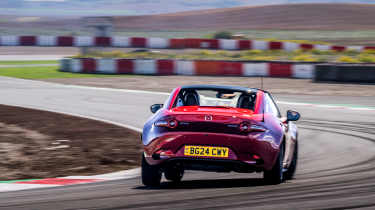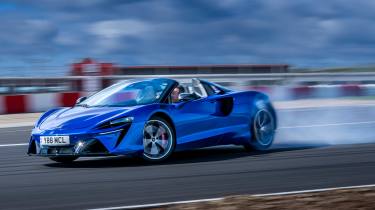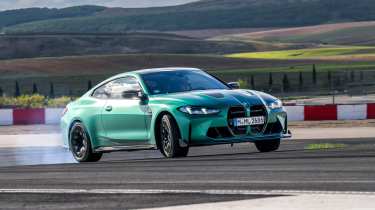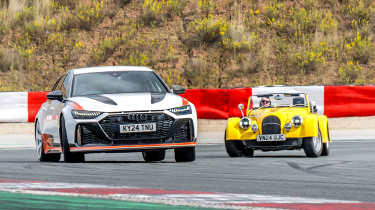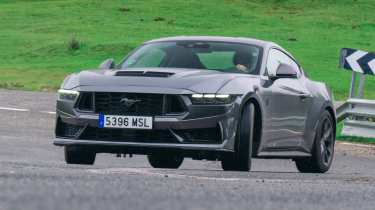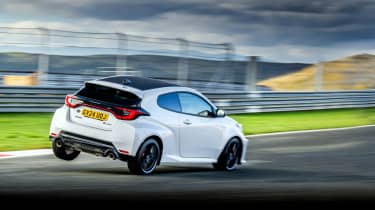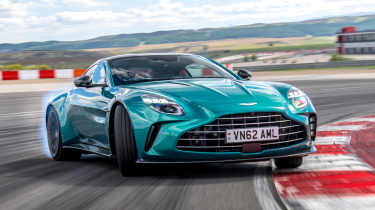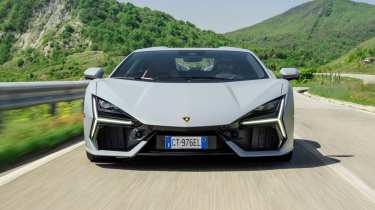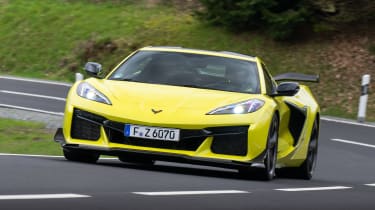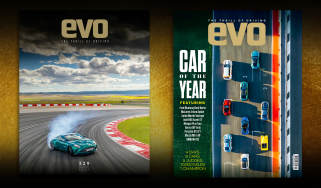evo Car of the Year 2024: Video, contenders and podcast
Nine of the best performance cars of last year gather together for the year's biggest test: evo Car of Year 2024.
evo Car of the Year drills down to the heart of what makes a great performance car, pitting the most thrilling models launched in the last 12 months against each other in the ultimate showdown. In spectacular locations and in the company of evo’s senior road test team, the good will be sorted from the great, and the very best will be crowned.
For 2024, Northern Spain was the location of choice, with stunning roads in the Pyrénées and Circuito de Navarra hosting nine of our favourite current performance cars. Some punched well above their weight, others fell a little short of expectations. There were affirmations of our suspicions of course but also surprise star turns. Find the full test and verdict in the video linked above, now. You can also still buy a copy of the evo Car of the Year issue of the magazine at the evo shop.
The cars of evo Car of the Year 2024
In episode ten of the evo podcast, contributing editor Henry Catchpole joined editor-in-chief Stuart Gallagher, deputy editor James Taylor and editors at large Dickie Meaden and John Barker to discuss eCoty 2024: the contenders, the test's highs and lows, the finishing order and the absentees.
You can also read below, the full lineup of the nine cars that made it into the test, as well as an overview of cars that couldn’t make it. The full film of the test will be out soon…
Mazda MX-5 RF
Your eyes are not deceiving you, this is a Mk4 (or ND for the aficionados) Mazda MX-5. A car that has been on sale since 2015 and in that time has never made the eCoty shortlist. Or the long list for that matter. So why now? What has Mazda done to earn itself a place in our biggest test of the year?
Incremental improvements are the key. As with many of the cars this year, the foundations may be familiar and well established but what has been put on top of late has made a considerable impact. And the MX‑5 is no different to the Audi, Ford, McLaren and even the Porsche in this regard.
While there are some mild design updates around the headlights, what piqued our interest – and our heart-rate when we first drove the 2025-model-year MX‑5 – was the fitment of a new asymmetric limited-slip differential. There’s also a new Track mode to help you exploit it.
The Bilstein dampers have been massaged, the electric power steering upgraded to reduce friction and increase clarity. And the weight, in the RF form we have brought to Spain? Just 1096kg. How refreshing is that?
As with the GR Yaris, the MX‑5 will need to rely on more than its compact dimensions and bantamweight mass; rose-tinted glasses aren’t allowed at eCoty, so espousing an old-school philosophy in a modern world won’t cut it either. But as evo web editor Ethan Jupp explained in issue 328, the MX‑5 remains one of the very best driver’s cars there is: ‘The MX‑5 has never shone so brightly than in a world seemingly hell-bent on dispensing with the principles of simplicity, lightness and interactivity.’
2025 Mazda MX-5 specs
| Engine | In-line 4-cyl, 1998cc |
|---|---|
| Power | 181bhp @ 7000rpm |
| Torque | 151lb ft @ 4000rpm |
| Weight | 1096kg |
| Power-to-weight | 168bhp/ton |
| 0-62mph | 6.8sec |
| Top speed | 136mph |
| Basic price | £34,335 |
McLaren Artura Spider
Hang on, isn’t the McLaren Artura older than the 750S that appeared in last year’s eCoty, and didn’t the Artura appear in 2022’s contest? What’s going on? Quite simply, the updates McLaren has introduced to the Artura this year are much more than a mid-life uplift. In fact, the car feels a bigger step on from the original coupe launched in 2022 than the transition from 720 to 750S.
The 20bhp increase means little in a car that already had 671bhp, but the new engine mounts, updated control unit for the Proactive Damping Control, new damper valves and recalibration of the adaptive software add to the Artura’s already strong dynamic armoury. Then there are the new shim-stacks for the dampers, while the steering, already among the very best there is, now has less kickback and even more feel.
‘The dynamic improvements and the more exciting performance delivery potentially lift the McLaren above the Ferrari 296,’ was Stuart Gallagher’s summary when he drove the car back in the summer (evo issue 325). The Artura and 296 couldn’t be split in 2022, both squeezing onto the third step of that year’s podium. A gentle stroll to the top step this year perhaps?
There’s no denying McLaren’s pedigree in creating some of the very best performance cars, but there are no foregone conclusions at eCoty. This is no like-for-like comparison. There’s more subjective weighting here, and bare-bones numbers are only an ingredient, not the meal, so while the Artura is clearly a strong contender it will need to be constantly looking over its shoulder while keeping an eye on what’s playing out ahead.
McLaren Artura Spider specs
| Engine | V6, 2993cc, twin-turbo, plus e-motor |
|---|---|
| Power | 691bhp @ 7600rpm |
| Torque | 531lb ft @ 2250-7000rpm |
| Weight | 1560kg |
| Power-to-weight | 450bhp/ton |
| 0-62mph | 3.0sec |
| Top speed | 205mph |
| Basic price | £221,500 |
BMW M4 CS
BMW M was keen for the M4 CS to be in eCoty this year, primarily because we were including a track element and secondly because they feel the 4 is a better car than the 3, which finished sixth in 2023’s competition.
Regular readers will know that the CS genre and eCoty have a strong history. The M2 CS was the first BMW to take the evo Car of the Year crown back in 2020 and the double was achieved in 2021 with a follow-up win for the M5 CS. But it’s gone a bit downhill since then, with the M4 CSL not exactly covering itself in glory 12 months after the 5’s success (although we suspect the CSL is, like its GTS forebears, a car that’s particularly sensitive to set-up) and the M3 CS missing the podium last year.
John Barker was the only team member to have driven the M4 CS prior to this year’s contest, and only on track (evo 323), but he was thoroughly enthused about the latest M car: ‘The BMW M4 CS is devastatingly quick yet easy to handle and exploit, with well-weighted, responsive steering and terrific balance,’ he wrote. Which sounds just the car for eCoty ’24. One built for the quicker road sections we have lined up – and the circuit.
But as we’ve discovered over the years, having a very specific set of attributes might help you rise above the crowd in one scenario but see you sink in plenty of others.
BMW M4 CS specs
| Engine | In-line 6-cyl, 2993cc, twin-turbo |
|---|---|
| Power | 542bhp @ 6250rpm |
| Torque | 479lb ft @ 2750-5950rpm |
| Weight | 1760kg |
| Power-to-weight | 313bhp/ton |
| 0-62mph | 3.4sec |
| Top speed | 188mph |
| Basic price | £120,345 |
Morgan Plus Four
As the Mk4 MX‑5 makes its eCoty debut, the Morgan Plus Four is on its second outing in its current guise, and like the Japanese roadster it too has had some very worthwhile tweaks. The bits we’re interested in, and the reason it is here, lie beneath its retro-styled aluminium body: namely, sophisticated Nitron dampers and a rear anti-roll bar. That’s all? Yep, and when we pitched it against a Lotus Emira in issue 324 its case to be here was made within the first few miles of driving it.
‘Pour the nose into a corner with the wonderfully uncorrupted steering and the sense of the opposing rear wheel aiding the process is clear, enhanced by the fact that you are sitting almost directly over the rear axle,’ marvelled Adam Towler. ‘It’s a wonderfully old-school but exploitable kind of handling balance.’ On the serpentine roads of the Pyrenees, the Plus Four should shine as brightly as its yellow paintwork.
But Morgan and evo know only too well that what works in (relative) isolation in the UK doesn’t always translate to success in eCoty. In 2019 the first of this new breed of cars from Malvern, the Plus Six, entertained us at Ascari and the surrounding roads, but the following year its four-cylinder brother fell some way short. Four years on, and while Morgan has worked tirelessly to update its icon, its charm is only going to take it so far.
So we’ll be looking for genuine depth to its talents, the ability to challenge not only the MX‑5 for our affections, but the Aston Martin and 911 too. Great cars come in all shapes and sizes; the Plus Four will want to prove this point more than perhaps any other car here.
Morgan Plus Four specs
| Engine | In-line 4-cyl, 1998cc, turbocharged |
|---|---|
| Power | 255bhp @ 5500rpm |
| Torque | 258lb ft @ 1000-5000rpm |
| Weight | 1044kg (dry) |
| Power-to-weight | 248bhp/ton (dry) |
| 0-62mph | 5.2sec |
| Top speed | 149mph |
| Basic price | £74,406 |
Audi RS6 GT
Imagine your three-, five- or ten-car fantasy garage and there’s a good chance a fast estate car will feature. But rarely does such practical performance metal make it onto an eCoty shortlist. Then again, the Audi RS6 GT is more than a fast estate car with some questionable graphics, as Dickie Meaden concluded when he first drove it back in issue 327: ‘It’s a project that defies logic yet ultimately delivers a special driving experience.’
How does it do this? There’s some trad RS6 hardware beneath the IMSA-inspired livery, which means a monstrous turbocharged V8, the latest-generation centre differential and a retuned rear diff to up the agility and offer greater rearward bias in Dynamic mode. Then there are the passive coilover dampers with three levels of adjustment and the beefed-up springs and anti-roll bars (30 and 80 per cent stiffer front and rear respectively). It sounds more Porsche 911 GT3 RS than RS6.
However, throwing some hardcore hardware at a car is one thing; making it all gel and come together to create a genuine thrill and an engaging driving experience is another challenge altogether. And a hardcore estate car? Audi Sport being let off the leash might work with R8 GTs, but this could be a concept too far.
Or perhaps not. On his first drive, Dickie messaged to say the GT reminded him very much of the BMW M5 CS, a comparison not to be ignored when you take into account how the BMW performed in eCoty ’21.
Audi RS6 GT specs
| Engine | V8, 3996cc, twin-turbo |
|---|---|
| Power | 621bhp @ 6000rpm |
| Torque | 627lb ft @ 2300-4500rpm |
| Weight | 2075kg |
| Power-to-weight | 304bhp/ton |
| 0-62mph | 3.3sec |
| Top speed | 190mph |
| Basic price | £177,115 |
Ford Mustang Dark Horse
How can you not include a car with the name ‘Mustang Dark Horse’ in a test such as this? Actually, we very nearly didn’t and it took all of Ford UK’s persuasive powers to convince their Spanish colleagues to allow us to commandeer their demonstrator for a week.
In a world where Ford of Europe is all but out of the internal combustion game when it comes to passenger cars, the rest of the Ford empire still sees a future for the internal combustion engine. For now. The Dark Horse isn’t exactly a last roll of the dice, but there is a sense the engineers have had the shackles eased a little.
Beneath its familiar shape (the Mk7 Mustang is a heavy reworking of the previous-gen car rather than a clean-sheet design) are tuned suspension components including bracing for the struts to improve steering feedback, larger anti-roll bars and unique calibration of the MagneRide dampers. There are some mighty, six-piston Brembo brakes, too, and sticky Pirelli rubber.
Dep ed James Taylor reckoned it a significant upgrade on the impressive Mach 1 when he drove the car late in ’23 (evo issue 314): ‘It builds on the genuinely talented Mach 1 with more polished handling and genuine track capability… there’s nothing else out there quite like it.’
Its muscle-car credentials will only get it so far this week, though, and while the quality and the detail that Ford Performance has been injecting into the Mustang for more than a decade has elevated it to a level where it outperforms some more storied marques, this will be its biggest test. On paper, it has the credentials to claim some major scalps, but it’s on the road that counts.
Ford Mustang Dark Horse specs
| Engine | V8, 5038cc |
|---|---|
| Power | 447bhp @ 7250rpm |
| Torque | 398lb ft @ 5100rpm |
| Weight | 1762kg |
| Power-to-weight | 258bhp/ton |
| 0-62mph | 4.4sec |
| Top speed | 163mph |
| Basic price | £67,995 |
Porsche 911 S/T
Frankenstein’s monster or the very best that Andreas Preuninger and his team in the Porsche GT department can create when the very best bits of all the 992 GT cars are made available to them? It’s going to be the latter, isn’t it? This is Porsche after all.
Let’s look at the evidence: the lightest 992 that Porsche has made, the clean looks of the GT3 Touring paired with the firebomb motor from the GT3 RS – albeit detuned with its own cams and cylinder heads – and combined with a six-speed manual transmission and the fewest drive modes they can get away with. Oh, and the small matter of a single-mass flywheel and lightweight clutch, the removal of rear-wheel steering, plus a tweaked differential… You get the picture.
‘The Porsche 911 S/T is up there with the very best of 911-kind. It’s raw, demanding and totally engaging,’ was James Taylor’s verdict in evo issue 316.Of course there is no such thing as perfect in the automotive world, Porsche 911 or otherwise. Those on-paper delights have to work on the road, otherwise they are little more than four-wheeled teases.
And, lest we forget, less extreme 911 GT products have tripped over their specifications on previous eCotys, most notably this car’s older brother, the GT3 Touring, which for a more ‘road-biased’ GT3 felt anything but in the Scottish Highlands in 2021. The S/T uses that car’s springs and dampers, albeit retuned with a bespoke set-up. A GT-division 911 designed for the road rather than the track runs contrary to much of what’s gone before, making the S/T’s performance here even harder to call.
Porsche 911 S/T specs
| Engine | Flat-six, 3996cc |
|---|---|
| Power | 518bhp @ 8500rpm |
| Torque | 343lb ft @ 6300rpm |
| Weight | 1380kg |
| Power-to-weight | 381bhp/ton |
| 0-62mph | 3.7sec |
| Top speed | 186mph |
| Basic price | £231,600 |
Toyota GR Yaris
Has there been a car more ‘of the moment’ than the Toyota GR Yaris? Since its launch in 2020 it hasn’t stopped bloodying the noses of all that take it on, such is the confidence and capability exuded by this pugnacious supermini on steroids. Which is why Gazoo Racing has fine-tuned, honed and polished what went before rather than reinventing the concept.
A stiffer shell, stiffer springs and anti-roll bars, recalibrated dampers and new suspension mountings are the details you can’t see, the revised seating position and upgraded interior the ones you can. It’s the mechanical changes that lift the GR above its peers once again.
‘The new car feels more alive, more eager at all road speeds, while feeling more useable day to day with less road noise and (mostly) better ergonomics. One of the very best hot hatches just got better,’ concluded James Taylor in evo 325. The toughest act the Yaris had to follow was its own, but now that it’s shown it’s more capable than ever, the next challenge begins.
It takes something special from a hot hatch to shine in eCoty. Their performance against their closest rivals may help build the hype, but amongst more specialist – and expensive – machines they can fade early and struggle to recover. But you’d be a brave person to bet against the rally rocket Yaris falling short this week.
Since the launch of the original, and now our exposure to this new, updated model, the GR Yaris has proven time and again that first and foremost it’s a great driver’s car: exuberant when you want, settled and useable when the occasion calls for it.
Toyota GR Yaris specs
| Engine | In-line 3-cyl, 1618cc, turbocharged |
|---|---|
| Power | 276bhp @ 6500rpm |
| Torque | 288lb ft @ 3250-4600rpm |
| Weight | 1280kg |
| Power-to-weight | 219bhp/ton |
| 0-62mph | 5.2sec |
| Top speed | 143mph |
| Basic price | £44,250 |
Aston Martin Vantage
Had timings worked, we could have had two new Aston Martins in this year’s test but having to ‘make do’ with only the Vantage was no hardship. Even before we drove it, the Aston Martin Vantage’s looks and specification suggested a hot rod that’d been developed by a hooligan and designed by someone with an eye for the aesthetic. When we drove it, such thoughts were only confirmed. Here was a car that elevated the entry point to Aston Martin ownership to an unprecedented peak of performance and desirability. Even more remarkable considering it carried over many of the hardpoints from its predecessor.
As with the DB12, the Vantage has undergone a nose-to-tail, top-to-bottom reinvention. Following the launch (evo 322), James Taylor wrote: ‘This is anything but a by-the-numbers car. Two days with the new baby Aston, on road and track, have demonstrated it’s a car about feel, feedback and carefully resolved details. Subjectively and objectively, this is a fun car, and a desirable one.’
Of course, a press launch is very different to the heat of an eCoty face-off and the Vantage is going to have to demonstrate that Aston Martin’s strategy of positioning itself as a maker of purer performance cars is one it has a hold on. On last year’s test the DB12 felt, at times, a little like it was falling into the gap between GT car and supercar, tripping itself up by trying to be both. The Vantage has a much clearer remit as a super-sports car, but headline numbers only get you so far and it will need to be at the very top of its game to achieve the result Aston expects and many of us hope for.
Aston Martin Vantage specs
| Engine | V8, 3998cc, twin-turbo |
|---|---|
| Power | 656bhp @ 6000rpm |
| Torque | 590lb ft @ 2000-5000rpm |
| Weight | 1670kg |
| Power-to-weight | 399bhp/ton |
| 0-62mph | 3.5sec |
| Top speed | 202mph |
| Basic price | £165,000 |
The Absentees
‘Where is X?’ ‘I can’t believe you didn’t include Y.’ ‘You should have had an XYZ… It’s a meaningless test without one.’ If you head to our YouTube channel in due course to watch this year’s glorious eCoty production, expect to see a whole bunch of comments along these lines. So we thought we’d answer them here, too.
Lamborghini Revuelto? It was the first car we booked, way back at the beginning of the summer – in fact Lamborghini chased us for dates, location and format. Then they pulled the car the week before the test. Which was a shame, as it was probably Sant’Agata’s best chance of taking its maiden eCoty crown. Next year? Perhaps.
> Driving the 1001bhp Lamborghini Revuelto on Italy's Raticosa Pass
Ferrari 12 Cilindri and Aston Martin Vanquish? The launch of the former was still taking place as we began shooting in Spain; the latter’s launch started the week we got back. We’ll bring them together in 2025 along with the Revuelto (if Lambo is playing ball, that is) for a traditional group test, but we’ll also extend invites to all three to attend eCoty ’25. Porsche 911 Carrera GTS T-Hybrid? It made it to the location a couple of weeks prior to eCoty starting, suffered a whoopsie and had to go home for some R&R. Porsche was, as you’d expect, gutted to have to send the S/T by way of an apology.
BMW M5? Another timing issue. The press cars had recently finished their international launch duties and our end-of-year celebration was a few weeks too soon. The same was the case for the Mercedes-AMG GT63 Pro and Bentley Continental GT Speed, both heavily updated new takes on old favourites. Looks like 2025 is going to be a busy year of testing.
Why no Mk8.5 Golf R or GTI Clubsport? They have both improved on their Mk8 predecessors but still fall some way short of being in the running for a podium finish. The updated Audi RS3 would have been up for consideration had it been available, but sadly its launch event had yet to take place when we started the test.
We would have liked to have had a Corvette Z06 this year, too, but as with previous years the small PR operation based in Europe wasn’t in a position to support our request. Maybe next time will be third year lucky.
GMA T.50, Aston Martin Valkyrie and Valour, Pagani Utopia and Codalunga? We’ll save the unobtainium for something else. Nothing electric (again)? We thought long and hard about bringing the Hyundai Ioniq 5 N along, but while it is the most impressive EV we’ve yet driven in terms of driver involvement, it remains a car you’d be happy to drive but not one you yearn to for the sake of it. The Alpine A290 could have been that car, but its launch was a month after eCoty was in the can.
And then there are the various restomods that appear regularly within these pages. These are rare and very special cars, especially remarkable when you consider the simple underpinnings that some are created from. They also tend to be the fruits of a particular individual’s imagination, exceptional one-offs. Even if you had the means to purchase one, such is the process of taking ownership – including starting with a very sparsely populated piece of paper – no two restomods are alike. To pit them against series-production cars, even ones that are limited in numbers such as the 911 S/T, wouldn’t deliver a truly representative result.

